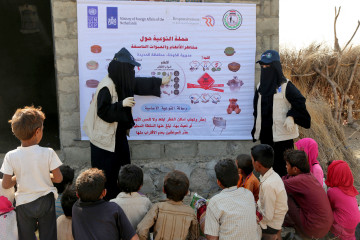

“If I could make a drawing about war, I would draw people with amputated hands and legs, injured eyes, injured arms and legs, and people walking with crutches,” says Maha*.
The 10-year-old from Taiz stepped on a landmine while collecting firewood with her sister last October. Even though Maha was rushed to the hospital for surgery, she lost her left eye and had her right hand amputated. Her sister Maya*, 16, was covered in shrapnel and badly injured in both legs.
"Almost half of all landmine and explosive remnants of war incidents involving children were deadly"
The two sisters are among the scores of children who have suffered such a fate, as a new analysis from Save the Children reveals that a child in Yemen was killed or injured by landmines or other explosive devices every two days on average during 2022.
This was the highest rate for at least five years, despite the UN-led truce from April to October.
While hostilities were de-escalated during this period, the proportion of child casualties caused by these deadly weapons rose as families returned home to the land that had been used as battlefields.
"As the country enters its ninth year of conflict, this report is a stark reminder of the devastating impact the war is having on children, Yemen's most vulnerable population"
“The fact that more and more children are being killed and injured by landmines and other explosive remnants of war is a damning indictment of the parties to the conflict who continue to use these weapons," said Save the Children’s Deputy Country Director for Yemen, Ashfaq Ahmad.
“As the country enters its ninth year of conflict, this report is a stark reminder of the devastating impact the war is having on children, Yemen's most vulnerable population."
|
This highlights the deadly legacy of the conflict, the aid agency said.
The war in Yemen has littered the country with landmines and unexploded ordnance (UXO) — weapons that failed to detonate such as artillery shells, grenades, mortars, rockets, and bombs.
Children encounter them in the course of everyday activities such as playing, collecting firewood and water, and tending to livestock.
According to Save the Children’s analysis, almost half of all landmine and explosive remnants of war incidents involving children were deadly.
While direct child casualties from armed violence, such as airstrikes, shelling or crossfire, have decreased since 2018, child casualties caused by the explosive remnants of war have risen - from an average of one every five days in 2018 to one every two days in 2022.
The report, Watching Our Every Step, found that child casualties from landmines and unexploded ordnance rose to 199 in 2022 – or 55% of all children casualties that year – compared to 68 in 2018, which was 7% of overall child casualties.
|
Decades of repeated conflict since the 1960s have left explosive devices scattered across the country, posing a constant threat to children's safety, particularly in rural areas. Children may lack the experience to identify or avoid them.
"We cannot continue to stand by and watch as children's lives are torn apart by these horrific weapons. All parties to the conflict must prioritise the protection of children and ensure that they are no longer exposed to the risks posed by landmines and other explosive devices,” Ahmad added.
With Yemen’s health system on the verge of collapse and few qualified rehabilitation specialists, children injured by these deadly weapons do not have access to the long-term care needed to recover their mobility, return to school, and reintegrate into community life.
Children in displacement camps are at greater risk of getting hurt by explosive devices due to a lack of mine risk education and the high risk of floods, which can cause these weapons to shift and drift.
"We cannot continue to stand by and watch as children's lives are torn apart by these horrific weapons. All parties to the conflict must prioritise the protection of children and ensure that they are no longer exposed to the risks posed by landmines and other explosive devices"
Out of the 194 child victims of landmines and other explosive devices Save the Children supported between 2020 and 2022, nearly one in four were internally displaced and the most common injuries treated included amputation of upper or lower limbs and hands, as well as loss of sight and hearing. In some cases, incidents led to permanent disability due to shrapnel and injuries to the spine.
Apart from physical injuries, children also reported the psychological distress they endured following explosive incidents, including trouble sleeping and daily fear and anxiety.
Jihad, a psychosocial specialist volunteer with Save the Children in Taiz, stepped on a landmine several years ago and now has a prosthetic leg. He uses his own experience to help reassure children like Maha and Miya that they will still be able to do anything they set their minds to.
“We enrolled the sisters in our psychosocial support programme,” said Jihad. “Throughout the weeks following the incident, I made sure their family was fully aware of the different phases of the physical, emotional, and psychological struggles that the girls would be facing and provided guidance on how to deal with each of them... My work is focused on helping children like Maha and Maya overcome these challenges and restore their confidence.”




 Follow the Middle East's top stories in English at The New Arab on Google News
Follow the Middle East's top stories in English at The New Arab on Google News


